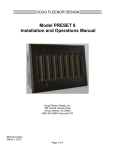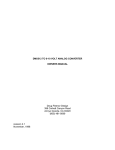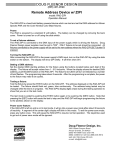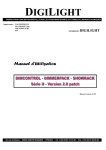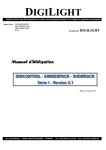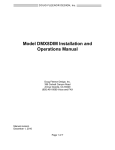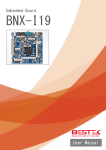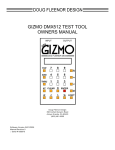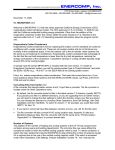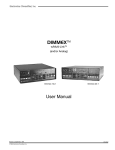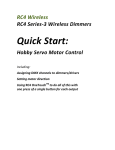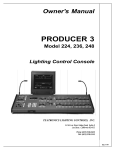Download Manual - Doug Fleenor Design
Transcript
DMX512 OPTICAL ISOLATOR OWNERS MANUAL Doug Fleenor Design 396 Corbett Canyon Road Arroyo Grande, CA 93420 (805) 481-9599 revision 2.0 December, 1996 PRODUCT DESCRIPTION The DMX512 Optical Isolator (DMX Opto Isolator) provides complete electrical isolation between lighting consoles and associated dimmers when installed in the control line. The electrical connections is broken by using an optocoupler which passes the control signal using a beam of light. Designed to protect the console from damage in the event of dimmer failure, the Opto Isolator may also be used to eliminate ground loops, protect against lighting damage, and buffer the DMX signal at control line intersections (wyes). The input stage of the DMX Opto Isolator is passive. The United States Institute for Theater Technology (USITT) standard for DMX512 calls for the input of a receiving device to meet EIA-485 specifications. The DMX Opto Isolator's passive input does not adhere to EIA-485, and so it's input does not strictly meet the DMX512 specification. See this manual's section on installation for more information on the Opto Isolator's input, why it doesn't meet DMX512, and why it doesn't need to. The DMX Opto Isolator uses a 10,000 Kilo Baud optocoupler. The DMX512 data rate is 250 Kilo Baud. The reason for using such a high speed optocoupler is to insure that the DMX Opto Isolator does not introduce any signal degradation, even when several are daisy-chained together. The DMX Opto Isolator's output section is fully DMX512 and EIA485 compatible. The output driver is also capable of 10,000 Kilo Baud operation. SETUP AND CONNECTIONS The DMX Opto Isolator is designed to be placed as close to the console as possible. In fact, it is possible to plug the isolator directly into the output jack of the console, and the control cable onto the end of the isolator. This method of connection eliminates the need for any additional cables. In some installations, the console is too close to the wall to allow the isolator to "hang off the back". In other cases the likelihood of damage to the "extended connector" makes the direct installation unwise. In these cases, a short (1 to 2 meter) DMX512 cable may be used between the console and the isolator, so that the isolator may be placed on the floor or table near the console. (The isolator does not need to be close to the console for proper operation. However the longer the cable between the console and the isolator, the less protection the isolator will provide from electro-magnetic induction). The DMX512 input to the isolator is a male 5 pin "XLR" style connector, the output is a female 5 pin connector. These are the connectors specified in the DMX512 standard. The mating connector for the input to the isolator is a female 5 pin connector such as the Switchcraft model A5F. The mating connector for the output from the isolator is a male 5 pin connector such as the Switchcraft model A5M. 1 The input to the DMX Opto Isolator is passive, and, since the DMX512 standard specifies an active input, the DMX Opto Isolator's input does not meet the DMX512 specification. This is not a serious drawback, however, since the Opto Isolator is designed to be the only load on a particular console port (whereas there are usually several dimmers connected to one port). The isolator's output meets the full DMX512 specification, however, and restores the full drive capability of the port. (The fact that the isolator's input is passive is another reason it is recommended that it be placed close to the console). DMX Opto Isolator Input Pinouts 5 pin male "XLR" style (accepts DMX512) 1 2 3 4 5 - No Connection Data Complement (-Data) Data True (+Data) No Connection No Connection DMX Opto Isolator Output Pinouts 5 pin female "XLR" style (meets DMX-512 standard) 1 2 3 4 5 - Common Data Complement (-Data) Data True (+Data) No Connection No Connection 2 BREAKING GROUND LOOPS The term Ground Loop refers to an electrical connection that results in two paths for current from one point to another, with one of the paths usually occurring through the building's electrical ground system. Ground loops result from two pieces of electrical equipment being connected to electrical power in different places, and then being connected together. In audio systems ground loops frequently occur, and can result in audible hum or buzz. The art of eliminating ground loops in audio systems is simplified by being able to hear the result; when the buzz goes away, the job is done. Serious ground loops in dimming systems are less common but can be difficult to trouble shoot if they exist. Unlike audio loops that result in an audible hum, a ground loop in a multiplexed dimmer control application may not have continuous visible symptoms. A ground loop in an analog multiplex system (AMX-192 or CD-80) can result in steady flicker, but even a bad ground loop in a digital multiplex system may not impair performance for long periods of time (hours or days). From one standpoint this is an advantage to digital multiplex... it is much more immune to noise and ground loops. On the other hand, if a problem exists, it is harder to pinpoint. When hum exists in an audio system, one useful tool to isolate ground is an audio transformer. The transformer passes the audio signal through a magnetic field while breaking the electrical connection. The DMX Optical Isolator provides a similar function for a DMX512 control signal. It passes the lighting control signal (using a beam of light) while breaking the electrical connection. If you suspect a ground loop is causing problems in your lighting system, a DMX Optical Isolator, installed at the console, will insure that no ground loop can be made through the isolator. Make sure, however, that there is no connection to the metal shell of your control wiring connectors. The isolator's shell is metal and will carry current around the isolator's internal isolation circuitry if a connection is made to the shell of the connector (only pins 1, 2, and 3 should have any connections to them). 3 PROTECTING AGAINST ELECTRICAL STORM DAMAGE Voltages induced on long control cables during electrical storms may be isolated from both the console and the dimmer input circuitry by placing an Opto Isolator at each end of the control cable. Shielded cable should then be used to connect the output of the isolator at the console to the input of the isolator at the dimmer with the shield connected to pin 1 at the console end and to a good earth ground at the dimmer end. Extremely high voltages, caused by direct strikes to lighting towers or power feeds may still cause damage. With Optical Isolators installed, this damage will hopefully be limited to the optocoupler or EIA-485 driver inside the isolator. In the event of such failure, the Optical Isolator may be easily replaced with a backup. The isolator may then be returned for repair without removing the console or dimmers from service. The repair to the isolator should be less expensive than repair to an unprotected dimmer or console, plus it's easier to ship. BUFFERING CONTROL LINE INTERSECTIONS (WYES) Editors Note: When this product was introduced in 1990 it was our only isolation product. Doug Fleenor Design now makes a complete line of isolation and distribution products, many of which are more suitable for the problems listed below. The following text is left in this manual as a guide on how to use the Optical Isolator when more suitable products are not on hand. The data rate of DMX512 is 250,000 bits per second. This is a relatively high data rate, and is susceptible to errors caused by signal distortion. One cause of signal distortion is "reflections". A reflection is caused when an electrical signal reaches the end of the wire; a portion of the electrical energy is reflected back up the wire. In a simple system, where the console is at one end of the wire and the dimmer(s) are at the other end, reflections may not be a significant problem. Since the dimmers are at the end of the wire, the reflection is not 'seen' by them, and the resulting signal distortion often does not cause errors. Consider what happens, however, if a dimmer is placed in the middle of the wire, such as if a run is made from the console to the stage right dimmers, and on to the stage left dimmers. The stage left dimmers are at the end of the cable and do not see the reflections going back up the wire. The stage right dimmers (located in the middle of the control run) see the initial control signal from the console, but it is distorted by the reflected signal coming back up the line. Two possible solutions exist to this problem... eliminate the reflections (see the section on line termination) or isolate the reflections from the dimmers in the middle of the control run. 4 Isolating the middle dimmers from reflections may be accomplished by placing a DMX Optical Isolator at the "loop through" connection of the dimmer in the middle of the control line. Since the isolator is a "one-way" device (receiving a signal on it's input and re-transmitting it on it's output) the reflection cannot go backwards through the isolator and distort the signal reaching the middle dimmer: +---------+ +--------+ +----------+ +--------+ | CONSOLE |----------| DIMMER |-| ISOLATOR |-----------| DIMMER | +---------+ +--------+ +----------+ +--------+ The DMX Optical Isolator has a passive input which loads the control line more than a dimmer. If there are lots of dimmers ahead of the isolator, the console may not be able to drive all the dimmers and the isolator too. Although not likely, if placing the isolator after the dimmers causes the dimmers to flicker or blink, try placing the isolator just ahead of the middle dimmers: +---------+ +----------+ +---------+ +--------+ | CONSOLE |---------| ISOLATOR |-| DIMMERS |-----------| DIMMER | +---------+ +----------+ +---------+ +--------+ This configuration does not "isolate" the reflections but "suppresses" them by supplying a very strong, re-transmitted signal to the middle dimmers. It's not just because we make the isolator that we present the next solution (but we don't mind selling all those isolators either): +-------+ +--------+ +--------+ +---+ +--------+ +---+ |CONSOLE|-|ISOLATOR|------|ISOLATOR|-|DIM|-|ISOLATOR|------|DIM| +-------+ +--------+ +--------+ +---+ +--------+ +---+ In some cases this may be overkill... but it can't hurt. In fact the need to daisy chain isolators is the main reason the DMX Optical Isolator is 40 times faster than the DMX512 data rate; so that daisy chaining will not degrade the signal quality. And just look at all the protection you get from dimmer failure and storm damage! 5 Sometimes it is necessary for a control run to be split before reaching the first dimmer. The resulting "wye" connection is a reflection nightmare. Now you have reflections coming from two directions, and you can't even terminate both ends of the wye without overloading the console! +------+ +----------|DIMMER| | +------+ +-------+ | |CONSOLE|-----------------+ +-------+ | | +------+ +----------|DIMMER| +------+ Editors Note: The proper item to use in this situation is an isolated splitter. Doug Fleenor Design now makes splitters with three, five, and eleven outputs. These diagrams have been left in the manual for "emergency" use when no splitters are on hand. Presenting the ONE isolator solution: +------+ +----------|DIMMER| | +------+ +-------+ +--------+ | |CONSOLE|----------------|ISOLATOR|-+ +-------+ +--------+ | +------+ +----------|DIMMER| +------+ and the TWO isolator solution: +--------+ +------+ /|ISOLATOR|------------|DIMMER| +-------+ |+--------+ +------+ |CONSOLE|---------------+ +-------+ |+--------+ +------+ \|ISOLATOR|------------|DIMMER| +--------+ +------+ 6 LINE TERMINATION Line Termination refers to the electrical properties at the end of a control cable. In analog, and analog multiplex systems, line termination is less important than it is in high speed digital applications. Termination always improves DMX512's signal quality. In some simple cases it can be ignored with little loss of reliability. Line Termination becomes more important as cable length increases, and as more dimmers (receivers) are connected to the line. In complex systems, with dimmers separated by more than a few feet, termination is recommended. Termination is provided by connecting a resistor between the Data True (+Data) and Data Complement (-Data) lines at the very end of the control cable run (to the control out connector of the last dimmer). To be technically accurate, the value of the resistor should match the "characteristic impedance" of the wire used for control wiring. This "characteristic impedance" is often not known for the wire being used as control cable. A common impedance for RS-485 digital control cable is 120 Ohms. Even if the control cable used is not exactly 120 Ohms, terminating the control line with a 120 Ohm resistor is better than leaving it unterminated (at 22,000 Ohms). A simple "terminator" may be made by soldering a 120 Ohm 1/4 Watt resistor between pins 2 and 3 of a 5 pin "XLR" style connector, and plugging it into the last dimmer in the chain. It is suggested that the connector be wrapped with white electrical tape and labeled "DMX LINE TERMINATOR" for easy identification. If you don't like soldering, a professionally constructed terminator is available from Doug Fleenor Design. Editor's Note: Since this manual was first written in 1990, DMX512 systems have become more and more elaborate. Doug Fleenor Design now recommends termination of all DMX512 systems, regardless of complexity. Terminators cost less than $25.00. Why risk failure? 7 Typical Characteristic Impedances of Control Wire BELDEN SERIES NUMBER * NOMINAL IMPEDANCE 9804 100 Ohms 8132 120 Ohms 9829 100 Ohms 8332 Not Rated 9501 Not Rated 8102 100 Ohms 9729 100 Ohms 8162 100 Ohms 9990 50 Ohms* 9841 120 Ohms 9880 100 Ohms 8777 50 Ohms* 9873 50 Ohms* 9773 50 Ohms* EIA-485 drivers (on which DMX512 is based) are rated for a minimum load impedance of 60 Ohms. Use of cables with a characteristic impedance of less than 100 Ohms is not recommended. If such cables are used, terminate with a minimum of 60 Ohms. If the impedance of the control cable is not known, a termination of 120 Ohms is recommended. 8 OPERATION The DMX Opto Isolator has no operator controls; it is fully automatic. It should be left plugged in at all times for automatic operation. When a DMX signal is applied to the input, it is isolated by the optocoupler and instantly (within 1/10,000,000 second) retransmitted by the output driver. When the signal is removed from the input, the optocoupler is idle, however the output driver continues to drive the DMX line in an idle (high) state as long as the isolator is powered. The high state is the idle state as defined by the DMX512 specification. For power savings, the Converter may be unplugged, or plugged into a switched outlet, when not in use. There is no special sequence required in powering up the dimmers/console/isolator. The isolator has one indicator LED. This indicator is illuminated when a DMX signal is present on the input of the isolator. It is not a "power" indicator. It is normal for the indicator to change intensity slightly as dimmer levels are changed. This effect may be so slight that it is not noticeable. TECHNICAL DETAILS For those technical types out there, here is a brief description of how the DMX Opto Isolator works. Differential Digital Signals DMX512 uses a "differential" digital signal. A differential signal is a pair of signals which are inverse from one another. That is, when one is high, the other is low. Differential signals are common in both analog processing (balanced microphone cables) and digital processing (digital communications such as EIA-485). Differential signals are used to reduce the effect of electrical noise on long cable runs. When a differential signal is processed by the receiving circuit (microphone pre-amp or RS485 receiver for example) the noise can be eliminated but the signal remains. Differential signals always travel in pairs, and the wire on which they travel are usually twisted to insure any noise picked up is of equal magnitude on both wires. The noise must be of equal magnitude on each wire so that the receiving circuit can effectively subtract the noise and leave the signal. The pairs of signals are usually denoted by a plus (+) sign on the normal, or "hot", or "true" line and by a minus (-) sign on the inverted, or "return", or "complement" line. In DMX512, a third line, common, is run in addition to the differential signals. The DMX Opto Isolator ignores the common signal all together, and uses only the relative state of the differential signal. When the +data line is higher than the data line the LED indicator is illuminated and the output driver drives the +data line high, the -data line low. 9 When the -data line is lower than the +data line, the LED indicator is extinguished and the output driver drives the +data line low, the -data line high. When there is no drive to the isolator (such as when the console is turned off) the LED indicator is extinguished and the output driver drives the data lines to their idle state (+data line high, -data line low). ABOUT THE COMPANY Doug Fleenor Design is a semi-custom design and manufacturing company. Our current standard products include converters for many lighting control protocols, Optical Isolation products for DMX512, AMX192, and other digital protocols, and a Digital Multiplex Combine Unit (for combining two Digital Multiplex signals in a pile-on, route, or patch operation). All these standard products can be customized for particular needs. Doug Fleenor, Principle Engineer, has been designing for the entertainment industry since 1979. He spent the years from 1984 through 1990 as Teatronics' Chief Engineer. During this time his work on advancing multiplex control consoles, dimmers and systems earned him the nick-name "Doctor Mux". Doug Fleenor Design continues to provide solutions to multiplex control problems as well as designing custom and semi-custom control and dimming systems. WARRANTY Products manufactured by Doug Fleenor Design carry a five year warranty. If the product breaks due to a manufacturing defect, within five years of manufacture, Doug Fleenor Design will repair it. It is the customer's responsibility to return the product to Doug Fleenor Design (at the customer's expense). Doug Fleenor Design will repair the unit and return it to the customer (at Doug Fleenor Design's expense). If a trip is necessary to the customer's site to solve a problem, the expenses of the trip must be paid by the customer. If your unit is out of warranty, please call us anyway. We try to be fair on all repairs. If the failure was our fault, we will usually repair it at no charge regardless of the time period! We want you to be happy with your purchase. 10











